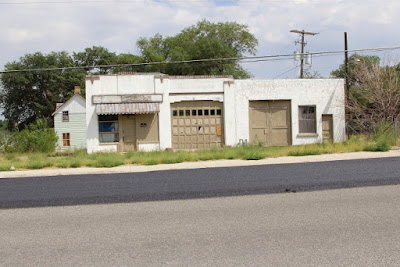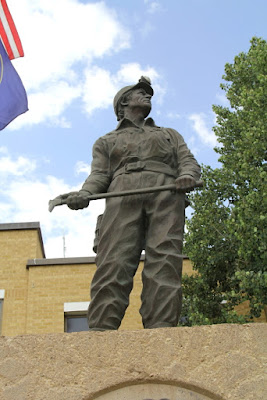After leaving the Cleveland-Lloyd Dinosaur Quarry, I followed some backroads and ended up in the community of Cleveland (2010 census population 464).
The population in Cleveland has been declining for several years and there are a number of vacant building in town. Similar to other town in Utah, Cleveland also has wide streets and a nice community park. The town was named after Grover Cleveland, President of the United States in the 1880s.
Samuel Agler and Henry Oviatt were the first homesteaders to arrive in 1884. They staked out their claims and were soon joined by 25 other families. People migrated to this area because the soil was more productive and required less water than other places in Emery County.
In 1890 a log school was constructed, but by 1893 the school had to be expanded because of population growth. By 1912 there was enough population in the area that a more permanent adobe-brick school was constructed. In 1910 a large opera house was built and was also used for dances, weddings, and starting in 1923 - silent movies! Unfortunately, the opera house no longer exists.
Huntington (2010 census population 2,129) is the largest town in Emery County.
Samuel Agler and Henry Oviatt were the first homesteaders to arrive in 1884. They staked out their claims and were soon joined by 25 other families. People migrated to this area because the soil was more productive and required less water than other places in Emery County.
In 1890 a log school was constructed, but by 1893 the school had to be expanded because of population growth. By 1912 there was enough population in the area that a more permanent adobe-brick school was constructed. In 1910 a large opera house was built and was also used for dances, weddings, and starting in 1923 - silent movies! Unfortunately, the opera house no longer exists.
Huntington (2010 census population 2,129) is the largest town in Emery County.
Huntington started as a farm community, but when coal was discovered in the area a number of the farmers turned into miners. Some of the workers divided their time between farming and mining because at that time there was a strong demand for Alfalfa seed that was grown in the area. The farmers also produced honey, which won first prize at the St. Louis World's fair in 1903.
On August 6, 2007, a shaft at Utah-American Energy's Crandall Canyon Mine collapsed, trapping six miners inside. Seismographs at the University of Utah measured the seismic waves from the collapse at 3.9-4.0 on the Richter Scale.
A rescue operation was started and then on August 16, the rescue tunnel collapsed killing three rescue workers and injuring an additional six miners. None of the miners or rescue workers could ever be saved.
There are a number of vacant buildings located on Main Street and the old high school that was built in 1923 is now a municipal building.
Orangeville (2010 census population 1,470) was founded in 1878 and named after Orange Seely, who was the first person called by the Church of Jesus Christ of Latter Day Saints to settle in the area. Like Huntington, many of the original farmers became miners and, unfortunately, there was also a mine disaster in Orangeville.
The worst coal mine fire in Utah history occurred on December 19, 1984, in the Wilberg Mine. The fire started from a faulty air compressor and spread quickly, cutting off the escape route. In total, 27 people died - 18 miners and 9 company officials.
Castle Dale (2010 census population 1,630) was settled in 1879 and is now the county seat of Emery County. Settlers named the community "Castle Vale" after the castle-like geological formations in the area; but when applying for a post office, the government misinterpreted the name and called the community "Castle Dale." Therefore, the community became "Castle Dale" instead of "Castle Vale."
Because of large coal deposits in the area, in 1970 Utah Power & Light Company built a steam-fired power plant two miles south of Castle Dale, which was an economic boost for the local economy.
Clawson (2010 census population 163) is a near ghost town; but, although quite small, the community still has a post office.
The town was originally called "Kingsville," after a family that first settled in the area. This was a "Mormon" community, so the town's name was later changed to Clawson in honor of Rudger Clawson, an Apostle of the Church of Jesus Christ of Latter Day Saints. In 1898 the first school opened. There were no teachers in the area, so Florence Barney rode a horse 14 miles each day to teach the children.
BONUS HISTORICAL STORIES & PICTURES
Even after the War ended, Wileta continued to make us military uniforms. She also made us some civilian clothes that we could wear when we were on shore leave.
On August 6, 2007, a shaft at Utah-American Energy's Crandall Canyon Mine collapsed, trapping six miners inside. Seismographs at the University of Utah measured the seismic waves from the collapse at 3.9-4.0 on the Richter Scale.
A rescue operation was started and then on August 16, the rescue tunnel collapsed killing three rescue workers and injuring an additional six miners. None of the miners or rescue workers could ever be saved.
There are a number of vacant buildings located on Main Street and the old high school that was built in 1923 is now a municipal building.
Orangeville (2010 census population 1,470) was founded in 1878 and named after Orange Seely, who was the first person called by the Church of Jesus Christ of Latter Day Saints to settle in the area. Like Huntington, many of the original farmers became miners and, unfortunately, there was also a mine disaster in Orangeville.
The worst coal mine fire in Utah history occurred on December 19, 1984, in the Wilberg Mine. The fire started from a faulty air compressor and spread quickly, cutting off the escape route. In total, 27 people died - 18 miners and 9 company officials.
Castle Dale (2010 census population 1,630) was settled in 1879 and is now the county seat of Emery County. Settlers named the community "Castle Vale" after the castle-like geological formations in the area; but when applying for a post office, the government misinterpreted the name and called the community "Castle Dale." Therefore, the community became "Castle Dale" instead of "Castle Vale."
Because of large coal deposits in the area, in 1970 Utah Power & Light Company built a steam-fired power plant two miles south of Castle Dale, which was an economic boost for the local economy.
Clawson (2010 census population 163) is a near ghost town; but, although quite small, the community still has a post office.
The town was originally called "Kingsville," after a family that first settled in the area. This was a "Mormon" community, so the town's name was later changed to Clawson in honor of Rudger Clawson, an Apostle of the Church of Jesus Christ of Latter Day Saints. In 1898 the first school opened. There were no teachers in the area, so Florence Barney rode a horse 14 miles each day to teach the children.
BONUS HISTORICAL STORIES & PICTURES
Even after the War ended, Wileta continued to make us military uniforms. She also made us some civilian clothes that we could wear when we were on shore leave.



























No comments:
Post a Comment